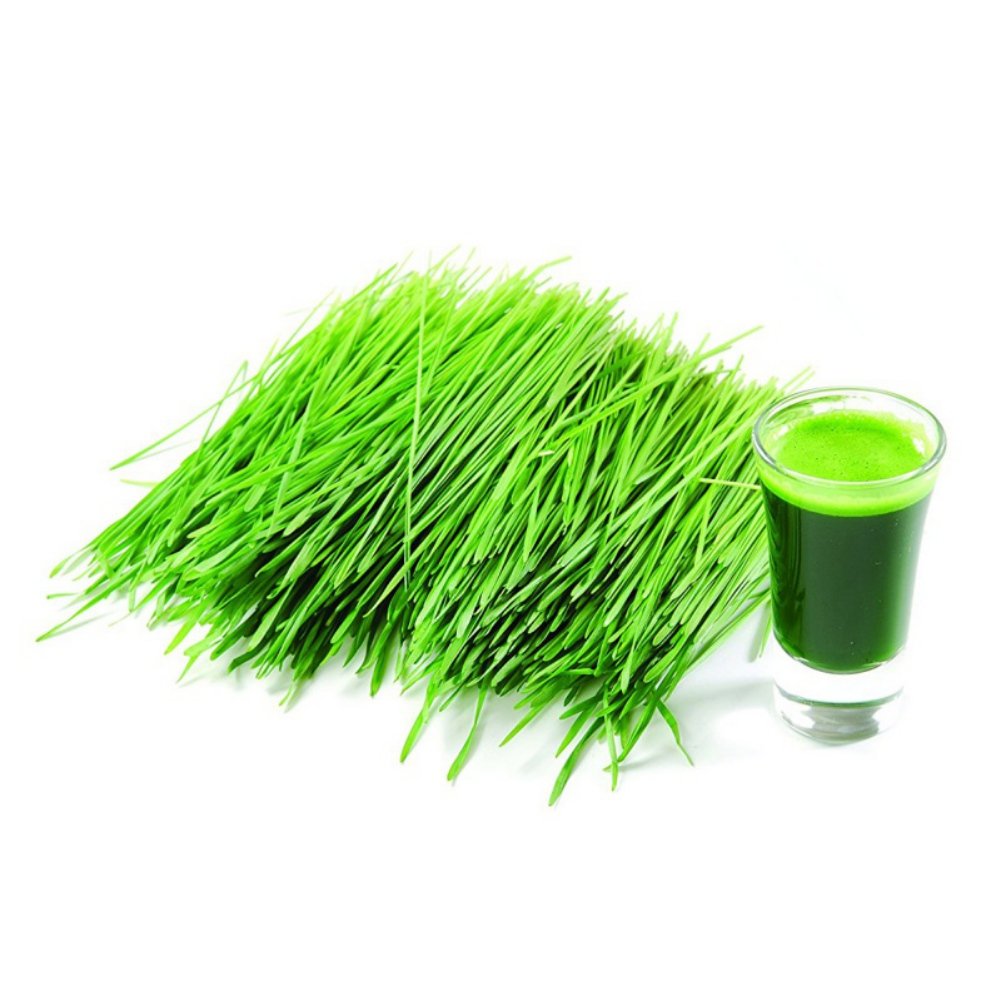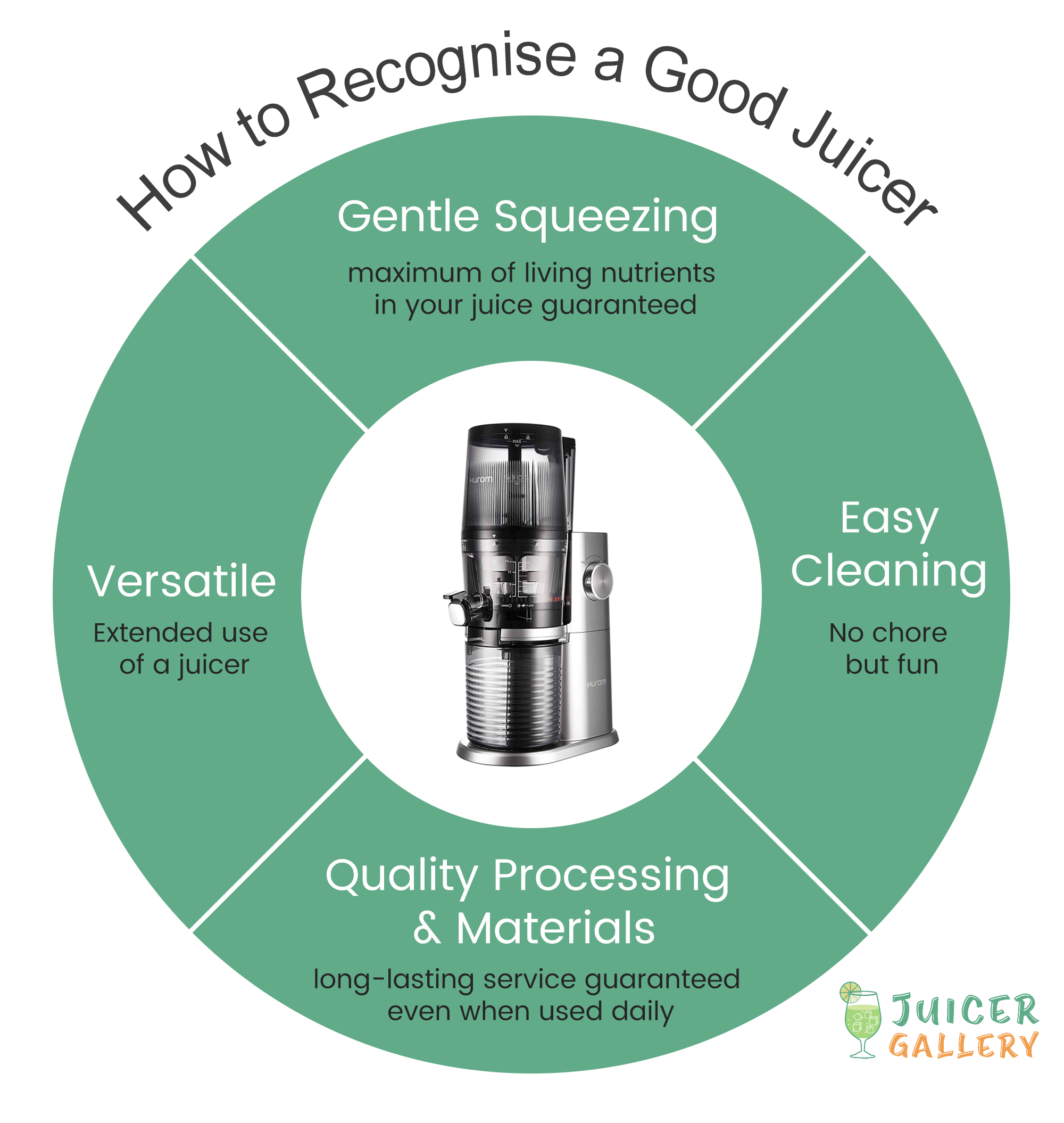There are tremendous health benefits to juicing and drinking fresh, healthy, and nutritious vegetable and fruit juice. You can just feel the energy and vitality flow through your body when you down a delicious glass of fresh-squeezed orange juice or wheatgrass juice. One of the reasons that fresh juice is so much healthier than store-bought juice is because of the difference in enzyme content. Juices sold in the store that are bottled or canned are not fresh because they have been heated to deactivate all of the enzymes. Without enzymes, bottled juices won’t oxidize and spoil, which significantly increases their shelf life. With fresh juice from a juicer you don’t have to worry about spoilage because you can drink the juice right after squeezing it. That way you can get all the benefits of the enzymes, vitamins, and minerals that are present in fresh juice.
To help you get the most juice out of your fruits and vegetables in the easiest and most efficient way possible, you need the best juicer you can find. My consumer guide for juicers will help you decide which machine will work best based on your lifestyle and dietary goals. Plus I have listed the most important features that you should be looking out for when you go shopping for your juicer.

There are three types of juicers; citrus juicers, multi-use juice extractors, and wheatgrass juicers. Citrus juicers and juice extractors work by grating or tearing and spinning the food to extract the juice. Wheatgrass juicers work by squeezing and pressing the food to get the juice out.
You should pick one of these three types based on your lifestyle and what you like to drink. If you’re like many new juicer users and just love the taste of fresh-squeezed orange juice in the morning, but you’re not really going to do a whole lot of other types of juicing, then all you really need is a nice citrus juicer.
If you’re into juicing spinach, and enjoy a glass of nutritious carrot juice after a workout, then you need to be looking at juice extractors. I found that after enjoying fresh orange juice so much I wanted to start juicing other fruits and vegetables too. I think you’ll find this to be the case with yourself even if you are just getting into juicing. Most of the juicers that I review on this site are multi-purpose juice extractors or wheatgrass juicers. If you plan on juicing every day, and trust me it can be a healthy addiction, then you need to invest in a nice, durable juice extractor or wheatgrass juicer.
If you are into drinking wheatgrass or just starting to add that to your diet, then you need a juicer that is specifically designed for that purpose. The good thing though is that wheatgrass juicers can be used with a wide variety of fruits and vegetables in addition to wheatgrass. Basically with these models you are getting a high end juicer that can handle just about anything.
Here is some more information on the different types of juicers.
Citrus Juicers
Citrus juicers are designed primarily for the citrus family of fruits which includes oranges, grapefruits, tangerines, lemons and limes. There are two types of citrus juicers; manual and electric.
Manual
With a manual citrus juicer, you just cut the fruit in half, place it onto a reamer, which is a cone with ridges on it, and press down. Then you twist the fruit to get the juice out. The juice usually falls down into a container under the reamer. This is the tried and true method of juicing that was used for centuries before any electric products came along to help with the process.
Advantages
- Inexpensive – These types of juicers are very inexpensive, most can be found for less than $30.
- Very durable – They don’t have moving parts or engines to deal with so they will last you a very long time.
- No electricity or batteries needed – Which means they are good for the environment and cost nothing to operate.
Disadvantages
- Require some elbow grease – You really have to push the fruit down on these and twist hard to get all the juice out.
- Slower – Electric models work faster, getting the same amount of juice out in a shorter period of time.
Electric
With an electric citrus juicer you just take a cut half of a fruit and press it down onto the reamer. The reamer then spins automatically and helps to squeeze out the juice. When you left up your hand and release the pressure, the reamer stops spinning. On some models the reamer will turn clockwise and then counterclockwise to extract the most juice. Many models also have different size juicing cones so that you can easily juice different size fruits like big grapefruits and small limes.
Advantages
- Very quick and easy – Electric juicers and a snap to use and will really squeeze out a lot of juice in a short amount of time.
Disadvantages
- More expensive than manual models – You certainly won’t break the bank on these, but they are more costly than manual juicers.
Multi-Use Juice Extractors
Juice extractors can be used with a variety of fruits, not just citrus fruits, and vegetables, including tomatoes, and spinach. More expensive models can handle hard vegetables like big carrots and beets, whereas cheaper models will work best on soft vegetables like cucumbers. You’ll even be able to juice the seeds, stems, and skins of different vegetables and fruits with higher end models.
Juice extractors use a shedder or grater to grind up fruits and vegetables into a nice pulp. These types of machines are also called centrifugal juicers because they use a fast spinning mesh basket or disk to grind the food item into a nice pulp as you push it down through a food tube. As the basket continues to spin, the liquid juice is separated from the solid pulp and drops down into a container. Some machines have an automatic pour spout for the juice, whereas with others you just remove the container and pour the juice out yourself.
In some machines, the leftover pulp stays in the basket until you dump it out. This limits the number of food items you can juice in a given amount of time before the basket gets clogged up. To speed up your juicing time, many models now offer auto pulp ejection. With this feature, the pulp is shot into another container outside of the mesh basket. The pulp can be dumped out or used in a variety of ways, from cooking to composting. You can even eat it if you want; there are a lot of nutrients in there. As a general rule of thumb, the drier the pulp, the more efficient the juicer.
Advantages
- Juice a wide variety of foods – You can juice a lot of different fruits and vegetables and are not limited to just citrus fruits.
- Fairly inexpensive – You can find most centrifugal juicers for under $200 and some much cheaper than that. Juice extractors are high end, high-quality machines.
Disadvantages
- Many have a difficult time with sprouts and leafy greens – The consistency of sprouts makes them hard to juice with a centrifugal juicer, and leafy greens tend to get mushed up without a lot of juice coming out.
- Foamy juice – Sometimes the juice may get foamy due to oxidation from the spinning. Some of the enzymes in the juice get destroyed when it oxidizes, so the health benefits are not as great.
Wheatgrass Juicers
Wheatgrass was first introduced as a drink and supplement to the Western world in the 1930′s after agricultural chemist Charles Schnabel proved its health benefits and curative properties. Schnable was able to nurse dying hens back to health and have them produce more eggs than healthy hens after introducing wheatgrass into their diets in scientifically controlled experiments. In humans, wheatgrass has been shown to promote general health and well being, and help with blood flow, digestion, and overall body detoxification. Wheatgrass has every single vitamin except vitamin D in it, as well as phytochemicals, minerals, and live enzymes that can aid with digestion.

Today you can find wheatgrass in a variety of health food stores in powered or dried form as well as at juice bars. Of course you can also buy it fresh at most grocery stores and juice it up yourself at home. There are even kits that you can buy so that you can grow your own wheatgrass organically at home.
Wheatgrass is tough to juice so you need a juicer that is specifically designed for this purpose. The good thing though is that you can use a wheatgrass juicer for a variety of other fruits and vegetables. You’ll also be able to make a lot of other cool stuff with the machine, like baby food, pasta, and even sorbets. Wheatgrass juicers come in two types, single gear (masticating) and twin gear (triturating), with the twin gear model being more expensive but stronger and more efficient.
Masticating Juicers (Single Gear)
Masticating juicers use an auger to grind up the food in a way very similar to how we eat and chew food with our teeth. The pulp from the fruit or veggie is pushed up against a mesh strainer so that the juice gets squeezed out and the pulp stays behind. You can get more juice out of the same amount of food using a masticating juicer than when using a centrifugal juicer. You’ll also get a lot less oxidation because masticating juicers don’t spin the food as much.

Advantages
- More efficient – Masticating juicers can squeeze out more juice than juice extractors
- Quiet – Single gear models are very quiet.
Disadvantages
- Single gear models can’t handle sprouts and leafy greens – Masticating models can’t pull the juice out of sprouts and leafy greens as well as twin-gear juicers.
- Slower – Masticating models are generally slower than centrifugal models.
Triturating Juices (Twin Gear)
Triturating juicers are the most efficient and versatile of all the different types of juicers. They work by grinding food using two interlocking gears. They are able to extract the most juice from food, and you can juice just about any fruit or vegetable. This includes not only wheatgrass but also leafy greens and sprouts. You’ll also be able to make a variety of other dishes including pate, sorbet, and baby food using your twin gear machine. You can even grind nuts to make almond butter and other types of nut butters.
Advantages
- You can juice just about anything – Powerful and efficient, you can juice to your heart’s content with a twin gear juicer.
- They extract the most juice – Of all of the models you’ll get the most juice out of your food. There is very little waste with a twin gear machine.
- Run at a low RPM (revolutions per minute) – Because twin gear models don’t spin the food as much, you get less foamy juice and minimal oxidation.
Disadvantages
- Expensive – Triturating juicers are the most expensive of all of the different types of juicers with some high end models running over $600. You get what you pay for here though, which is the best.
- You have to use a bit of force to get the food through – It can be a little bit harder than a single gear model to get the food through the twin gears on these machines.
- A little more cleanup is needed – You have to make sure you clean these models thoroughly because of all the moving parts. Also after you’re done you need to get the twin gears lined up properly when you’re putting the unit back together.
Features to Look For
There are several major features you should look for when you’re out shopping for a juicer. Some features may be more important to you than others based on your planned uses for the machine. Most of the features listed below apply to most types of juicers and understanding what they mean can help get you educated before you start your shopping.

Efficiency – You want to find the juicers that can extract the most juice. I feel like it’s such a waste if you leave good juice in the pulp of the fruit or vegetable and then have to just throw it away, all because the juicer you’re using can’t get the job done. Wheatgrass juicers are the most efficient of all of the different types of juicers at extracting juice from not only wheatgrass but also all other types of fruits and vegetables. The only drawback to high efficiency is that these juicers tend to be a bit slower. If you’re not going to be juicing wheatgrass and you don’t like waiting a little longer for your fruit juice then you should opt for a juice extractor instead of a wheatgrass juicer.
Motor Strength and Number of Speeds – The horsepower of the motor is an important feature to look at because you want a machine that will have enough power to juice quickly and not get burned out and overloaded. Weak motored machines cannot handle food with a core or thick skin. Also, having an engine with different speeds gives you more flexibility when juicing. Different foods, like soft tomatoes and hard carrots, require different speeds to properly juice.
Pulp Regulator – Some people like their juice really pulpy, with lots of big chunks in there. Others prefer a nice liquid with minimal amounts of pulp. Rather than having to scoop out pieces of pulp in your cup to get the right amount, many juicers will offer a regulator that lets you control how much pulp material gets in your drink. This is a really nice feature to have and offers a lot of flexibility.
Continuous Pulp Ejection – When you make a big pitcher of juice you want to be able to continue feeding fruit or vegetables into the machine. Without continuous pulp ejection you have to stop the machine and keep cleaning out the basket so that the mesh screen doesn’t get clogged, preventing the juice from getting spun out. This feature applies mainly to centrifugal juicers.
Feed Tube Size – Using a wheatgrass juicer with a large feeding tube you can just add your wheatgrass and fruits and vegetables into the machine with minimal precutting and chopping. It’s nice not having to take the time to cut everything up into small pieces so that it will fit into a small feeding tube. If you are looking at a wheatgrass juicer (this applies to both masticating and triturating models) then you need to look for one with a wide feeding tube that will handle big vegetables and fruits. However, if you are looking at a centrifugal juicer, then you need a smaller tube. A larger tube on a centrifugal model will result in some smaller pieces of food going down into the tube and not getting grinded up as well as the bigger pieces. When this happens you don’t get as much juice and there is a lot of waste. With a smaller tube all of the pieces are generally the same small size and are able to get evenly grinded and juiced.
Long Power Cord – A nice long cord lets you move the juicer around where you want it in the kitchen. In addition to a long cord you’ll also want to make sure you have a cord storage area under or within the machine. That way you can tuck it away nicely when you’re not using the machine.
Clear Juice Container – I like to see how much juice is in the jug without having to take the top of the juicer off. A nice clear container will tell you right away whether you need to juice a couple more oranges to get your cup of OJ or whether you already have enough juice.
Easy Cleanup – Juicers can be messy and pulp can get stuck down in crevices in the machine and forgotten. If this happens and you don’t stay on top of cleaning, your machine can get really gross really quickly and bacteria and mold can start to grow. Therefore to save time and make things easier you should opt for a dishwasher safe juicer and a pulp collector that is easy to access and remove. Many machines also come with a special brush to clean the pulp filter basket.
Warranty – The longer the warranty the better. I’ve found juicers with warranties from just 90 days up to 15 years, which is pretty amazing for any product. I wish my car had a 15 year warranty! Some warranties will also cover the motor for a longer time period than some of the other parts of the machine.
Noise – Your juicer won’t be nearly as loud as your blender, and many wheatgrass juicers are very quiet. When you’re juicing your oranges in the morning you don’t want to wake the whole house up, so the quieter the better. Some juicers provide information about sound levels; most do not, so you’ll need to read some reviews to learn more about the particular model you’re looking at. As a general rule of thumb, the faster a centrifugal juicer spins, in RPM’s, the louder it’s going to be.
Vibration – A lot of vibration in a juicer generally means it’s not designed that well. Or it could just be overloaded because of all those big carrots you just jammed in there. You won’t find any information about vibration on the packaging so you need to rely on reviews for this information.
Quality – Be sure to check leading consumer magazines like Consumer Reports and various owner review sites to see if there are any reports of overheating, breakage, or jamming. If you see a lot of negative reports then you should probably steer clear of the model you’re looking at. There are many high-quality models out on the market and I have some of the best ones listed and reviewed in detail on this site.
I hope you found this Consumer Guide for Juicers helpful. If you have a question or comment just add it below and I’ll see if I can help you out.

